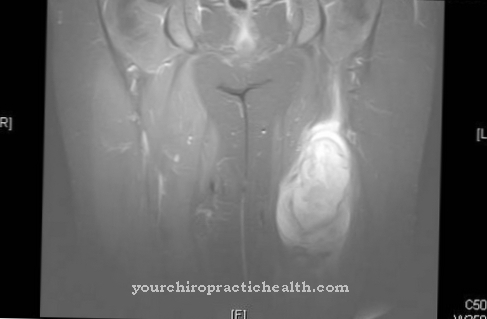A diabetic nephropathy Damage to the supplying kidney vessels as a result of excessively high blood sugar levels, which can lead to pronounced impairment of kidney function. Diabetic nephropathy is the most common reason for requiring dialysis in Germany.
What is Diabetic Nephropathy?

© Reing - stock.adobe.com
Diabetic nephropathy is damage to the glomerular (ball-shaped) capillaries of the kidney, which can often be observed in connection with long-term, particularly poorly controlled and more than ten to 15 years old diabetes mellitus (types I and II). In many cases, the symptoms of diabetic nephropathy only manifest themselves after years of advanced disease.
These include headaches, poor performance, anemia (anemia), edema formation in the legs (swelling due to water retention), weight gain, itching, and skin changes the color of milk coffee. In about a third of those affected by diabetes mellitus, nephropathy is associated with diabetic retinopathy.
In the advanced stages of diabetic nephropathy, dialysis and kidney transplants may be necessary due to the pronounced kidney damage. More than 30 percent of people who need dialysis in Germany are affected by diabetic nephropathy, making the disease the most common reason for needing dialysis.
causes
Diabetic nephropathy is caused by an elevated blood sugar level over a long period of time. The increased blood sugar level causes deposits in the large supplying blood vessels of the kidneys, which lead to a disruption of the blood flow (arteriosclerosis) and, as a result, an additional impairment of the smaller, glomerular vessels.
The kidney functions, especially the organ's filtering capacity and detoxification capacity, are severely disturbed, so that more proteins are excreted in the urine, especially the so-called albumin, which cannot be found in the urine of healthy people.
In addition, various factors such as hypertension (high blood pressure), increased blood lipid levels, poor blood sugar control, nicotine consumption, excessive protein intake from food and a genetic disposition (disposition) increase the risk of diabetic nephropathy.
Symptoms, ailments & signs
- Itching
- yellowish-brownish skin
- General weakness and poor resilience
- Water retention
- a headache
- Anemia (anemia), iron deficiency anemia
- Weight gain
Diagnosis & course
Diabetic nephropathy is diagnosed by the concentration of albumin in the urine. Since, for example, urinary protein levels are also increased in the case of urinary tract infections or febrile diseases, at least two out of three urine samples (morning urine) must have an increased albumin level for a reliable diagnosis.
The level of concentration can provide information about the stage of diabetic nephropathy. While at a value of 20 to 200 mg / l an onset of kidney disease can be assumed, the kidney damage is already to be classified as advanced at a value of over 200 mg / l. In addition, increased creatinine, uric acid and urea levels in the blood provide information about impaired kidney function and whether there is already chronic kidney failure.
With early diagnosis and therapy, the course of diabetic nephropathy can be slowed down and possibly stopped. In the long term, untreated diabetic nephropathy leads to severe impairment of kidney function and even to the need for dialysis.
Complications
A diabetic nephropathy results from a disturbed sugar balance, as is the case with diabetes mellitus, which can have a wide variety of complications. The increased sugar in the blood can lead to blockage of smaller vessels in the body and thus to an insufficient supply of the individual organs with blood and oxygen, which leads to their death.
On the one hand, the kidneys (diabetic nephropathy) are particularly affected. In the course of the process, the urine flow increases, which becomes less and less in the further stages. Kidney failure is on the horizon. This increases the risk of developing edema, but also of cardiac arrhythmias, since less potassium is excreted due to kidney failure, which increases the concentration in the blood (hyperkalemia).
Blood poisoning or uremia is also conceivable because toxins are no longer adequately excreted. Furthermore, in the context of diabetes, the vessels of the retina can become blocked (diabetic retinopathy). This can lead to a severe impairment of vision, which can lead to blindness. Nerves are also affected by diabetes (diabetic neuropathy), which can lead to sensitivity disorders, but also to motor disorders.
When should you go to the doctor?
In the case of this disease, a doctor must be consulted in any case, as there is no self-healing and the kidneys can be completely and irreversibly damaged as a result. A doctor should usually be consulted if the person already suffers from diabetes. The skin becomes itchy and the skin itself turns yellow or brown. If these complaints occur together with water retention or with tiredness and general weakness, a visit to the doctor is definitely necessary.
An iron deficiency and an increase in weight can also indicate this condition. Many patients also suffer from headaches. As a rule, the disease can be diagnosed by a general practitioner or an internist. Further treatment, however, depends on the progress of this disease and is then carried out by various specialists. The person concerned may then have to have a kidney transplant.
Doctors & therapists in your area
Treatment & Therapy
In the case of diabetic nephropathy, the therapeutic measures aim first and foremost at an optimal setting of the blood sugar values, as this slows down the course and eliminates the kidney damage in the early stages.
In addition, the medication should be checked and, if necessary, the long-term therapy should be adjusted. For example, those affected by diabetic nephropathy should not take the frequently used antidiabetic drug metformin, as it aggravates renal insufficiency and is therefore contraindicated (unsuitable). In addition, the blood pressure value should be kept as low as possible in diabetic patients with kidney disease, since the kidneys can function better at a low value.
In addition, antihypertensive agents such as ACE inhibitors and angiotensin II antagonists are used, which not only minimize the risk of the progression of diabetic nephropathy, but also that of heart attacks and strokes. Furthermore, other risk factors such as increased blood lipid levels must be treated. In many cases of diabetic nephropathy, a change in diet to a low-protein and low-salt diet, as well as reducing excess weight and abstaining from nicotine consumption, is recommended.
In the advanced stages of diabetic nephropathy, dialysis (blood washing) or a kidney transplant is indicated in most cases, since irreversible (irreversible) damage is already present at this point.
Outlook & forecast
The prognosis of diabetic nephropathy is considered unfavorable. Since the cause is a poorly treated diabetes disease, there have already been several years in advance in which the blood sugar values were incorrectly set. Among other things, this has an impact on the organic activity of the kidneys and shortens the life span of the patient.
With a change in medical care and a healthy lifestyle, the patient can have a positive influence on his well-being. However, the resulting damage to the kidney is considered irreparable. The rate at which the disease progresses in diabetes can be influenced. The functionality of the kidneys is still impaired. In severe cases, diabetic nephropathy leads to organ failure and thus to death of the patient.
In addition to good diabetes treatment, those affected have regular dialysis. This is an immense burden and can lead to a mental disorder. Other illnesses also worsen the prospect of recovery. In favorable cases, a donor kidney is found and the patient is eligible for a kidney transplant.
As soon as this runs successfully, the lifetime can be successfully extended. However, impairments are to be expected. In addition, good medical treatment for diabetes is essential to prevent recurrence of symptoms or kidney problems.
prevention
Diabetic nephropathy can be prevented through regular check-ups (blood pressure and fat, protein content in the urine) and a good blood sugar control. In addition, a change in diet to a low-salt and low-protein diet is recommended. With an early diagnosis and timely start of therapy, kidney failure due to diabetic nephropathy can be avoided.
Diabetic nephropathy
Since diabetic nephropathy is a frequent but also dangerous secondary disease of diabetes mellitus, it requires regular and professional follow-up care by an experienced nephrologist. During the controls, the doctor should take blood from the patient and check the kidney values in order to detect early on any possible impairment of kidney function.
In this way, impending kidney failure can be prevented. If necessary, the nephrologist can perform a biopsy in order to be able to make an exact statement about the stage of the kidney damage. Dialysis or, in the worst case, a kidney transplant may be necessary in the course of the process, which the patient should be informed about.
If diabetic nephropathy occurs as part of an untreated diabetes mellitus, the patient should be referred to an appropriate specialist so that the patient is trained and trained with the appropriate medication and insulin, as taking the medication can be very complex.
The doctor should also regularly prescribe blood sugar checks to check the setting for the medication and, if necessary, change it. In addition to the kidneys, the eyes are also often affected, which is why the patient should go to an ophthalmologist for an annual check-up. With the help of a reflection of the fundus of the eye, this can detect changes early and thus prevent blindness.
You can do that yourself
If diabetic nephropathy is diagnosed, the first self-help measure is to optimally adjust the blood sugar and to avoid high blood pressure, as the kidneys are additionally stressed by hypertension. With the above measures, people suffering from diabetes can slow down the course of diabetic nephropathy or even stop it completely. This is regardless of whether it is the more common type 2 or type 1 diabetes.
In the early stages, the kidneys can regenerate completely. The disease is caused by damage to the blood vessels supplying it and the glomerular capillary vasculature of the kidneys. The vascular damage can usually be traced back to a suboptimally adjusted blood sugar concentration that has persisted for years.
In some cases, certain drugs are causally responsible. Sclerotic deposits develop in the vessels, so that kidney function is impaired and can fail completely in the end stage, so that only dialysis and a kidney transplant can remedy the situation.
Regardless of the optimal blood sugar and pressure settings, one self-help measure is to identify typical symptoms of diabetic nephropathy. Typical signs can be frequent itching and a slight yellow-brownish discoloration of the skin. Less specific symptoms are a general low resilience, headache and water retention (edema) in the body and a resulting weight gain. Usually there is also general iron deficiency anemia.




.jpg)



















.jpg)



